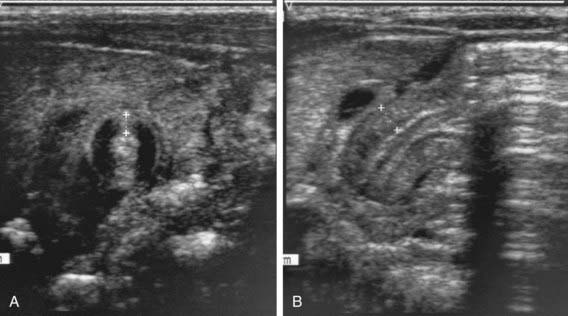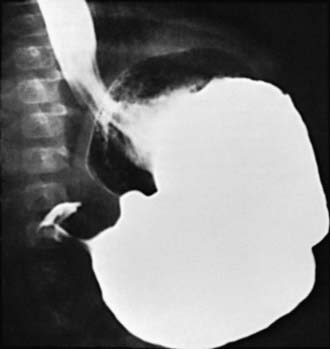Chapter 321 Pyloric Stenosis and Other Congenital Anomalies of the Stomach
321.1 Hypertrophic Pyloric Stenosis
Hypertrophic pyloric stenosis occurs in 1-3/1,000 infants in the United States. It is more common in whites of northern European ancestry, less common in blacks, and rare in Asians. Males (especially first-borns) are affected approximately 4 to 6 times as often as females. The offspring of a mother and, to a lesser extent, the father who had pyloric stenosis are at higher risk for pyloric stenosis. Pyloric stenosis develops in approximately 20% of the male and 10% of the female descendants of a mother who had pyloric stenosis. The incidence of pyloric stenosis is increased in infants with B and O blood groups. Pyloric stenosis is occasionally associated with other congenital defects, including tracheoesophageal fistula and hypoplasia or agenesis of the inferior labial frenulum.
Etiology
The cause of pyloric stenosis is unknown, but many factors have been implicated. Pyloric stenosis is usually not present at birth and is more concordant in monozygotic than dizygotic twins. It is unusual in stillbirths and probably develops after birth. Pyloric stenosis has been associated with eosinophilic gastroenteritis, Apert syndrome, Zellweger syndrome, trisomy 18, Smith-Lemli-Opitz syndrome, and Cornelia de Lange syndrome. An association has been found with the use of erythromycin in neonates with highest risk if the medication is given within the 1st 2 wk of life. There have also been reports of higher incidence of pyloric stenosis among mostly female infants of mothers treated with macrolide antibiotics during pregnancy and breastfeeding. Abnormal muscle innervation, elevated serum levels of prostaglandins, and infant hypergastrinemia has been implicated. Reduced levels of neuronal nitric oxide synthase (nNOS) have been found with altered expression of the nNOS exon 1c regulatory region, which influences the expression of the nNOS gene. Reduced nitric oxide might contribute to the pathogenesis of pyloric stenosis.
Clinical Manifestations
Nonbilious vomiting is the initial symptom of pyloric stenosis. The vomiting may or may not be projectile initially but is usually progressive, occurring immediately after a feeding. Emesis might follow each feeding, or it may be intermittent. The vomiting usually starts after 3 wk of age, but symptoms can develop as early as the 1st wk of life and as late as the 5th mo. About 20% have intermittent emesis from birth that then progresses to the classic picture. After vomiting, the infant is hungry and wants to feed again. As vomiting continues, a progressive loss of fluid, hydrogen ion, and chloride leads to hypochloremic metabolic alkalosis. Greater awareness of pyloric stenosis has led to earlier identification of patients with fewer instances of chronic malnutrition and severe dehydration and at times a subclinical self-resolving hypertrophy.
Hyperbilirubinemia is the most common clinical association of pyloric stenosis, also known as icteropyloric syndrome. Unconjugated hyperbilirubinemia is more common than conjugated and usually resolves with surgical correction. It may be associated with a decreased level of glucuronyl transferase as seen in ∼5% of affected infants; mutations in the bilirubin uridine diphosphate glucuronosyl transferase gene (UGT1A1) have also been implicated. If conjugated hyperbilirubinemia is a part of the presentation, other etiologies need to be investigated. Other coexistent clinical diagnoses have been described, including eosinophilic gastroenteritis, hiatal hernia, peptic ulcer, congenital nephrotic syndrome, congenital heart disease, and congenital hypothyroidism.
The diagnosis has traditionally been established by palpating the pyloric mass. The mass is firm, movable, ∼2 cm in length, olive shaped, hard, best palpated from the left side, and located above and to the right of the umbilicus in the mid-epigastrium beneath the liver’s edge. The olive is easiest palpated after an episode of vomiting. After feeding, there may be a visible gastric peristaltic wave that progresses across the abdomen (Fig. 321-1).
Two imaging studies are commonly used to establish the diagnosis. Ultrasound examination confirms the diagnosis in the majority of cases. Criteria for diagnosis include pyloric thickness 3-4 mm, an overall pyloric length 15-19 mm, and pyloric diameter of 10-14 mm (Fig. 321-2). Ultrasonography has a sensitivity of ∼95%. When contrast studies are performed, they demonstrate an elongated pyloric channel (string sign), a bulge of the pyloric muscle into the antrum (shoulder sign), and parallel streaks of barium seen in the narrowed channel, producing a “double tract sign” (Fig. 321-3).

Figure 321-2 A, Transverse sonogram demonstrating a pyloric muscle wall thickness of >4 mm (distance between crosses). B, Horizontal image demonstrating a pyloric channel length >14 mm (wall thickness outlined between crosses) in an infant with pyloric stenosis.
Differential Diagnosis
Gastric waves are occasionally visible in small, emaciated infants who do not have pyloric stenosis. Infrequently, gastroesophageal reflux, with or without a hiatal hernia, may be confused with pyloric stenosis. Gastroesophageal reflux disease can be differentiated from pyloric stenosis by radiographic studies. Adrenal insufficiency from the adrenogenital syndrome can simulate pyloric stenosis, but the absence of a metabolic acidosis and elevated serum potassium and urinary sodium concentrations of adrenal insufficiency aid in differentiation (Chapter 570
Stay updated, free articles. Join our Telegram channel

Full access? Get Clinical Tree




